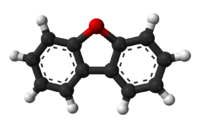Dibenzofuran
| Dibenzofuran | |
|---|---|
 | |
 | |
| Identifiers | |
| CAS number | 132-64-9 |
| PubChem | 568 |
| ChemSpider | 551 |
| KEGG | C07729 |
| ChEBI | CHEBI:28145 |
| ChEMBL | CHEMBL277497 |
| Jmol-3D images | Image 1 |
| |
| |
| Properties | |
| Molecular formula | C12H8O |
| Molar mass | 168.19 g/mol |
| Appearance | white to pale yellow crystalline powder |
| Melting point | 81 - 85 °C |
| Boiling point | 285 °C |
| Solubility in water | Insoluble |
| Hazards | |
| R-phrases | R51/53 |
| S-phrases | S24/25 S29 S61 |
| Related compounds | |
| Related compounds | Furan Benzofuran Dibenzodioxin Dibenzothiophene Carbazole Polyozellin (compound with a kernel with two dibenzofurans that share the same benzene ring) |
| Except where noted otherwise, data are given for materials in their standard state (at 25 °C (77 °F), 100 kPa) | |
| Infobox references | |
Dibenzofuran is a heterocyclic organic compound with the chemical structure shown at right. It is an aromatic compound that has two benzene rings fused to one furan ring in the middle. All the numbered carbon atoms have a hydrogen atom bonded to each of them (not shown in the image). Dibenzofuran is an aromatic ether having the chemical formula C12H8O.
Dibenzofurans
Dibenzofurans can also inaccurately refer to polychlorinated dibenzofurans (PCDFs), a family of organic compounds with one or several of the hydrogens in the dibenzofuran structure replaced by chlorines. For example, 2,3,7,8-tetrachlorodibenzofuran (TCDF) has chlorine atoms substituted for each of the hydrogens on the number 2, 3, 7, and 8 carbons (see structure below). Polychlorinated dibenzofurans are much more toxic than the parent compounds, with properties and chemical structures similar to polychlorinated dibenzodioxins. These groups together are often inaccurately called dioxins.

Environmental and health consequences
Probable places of origin It is a white crystal-like solid created during the production of coal tar.[1] It is used as an insecticide, in the production of polyvinyl chloride, in industrial bleaching and in incineration.
Production and Producers: Dibenzofuran is recovered from a wash oil fraction of coal tar that boils between 275 °C and 290 °C. Redistillation separates dibenzofuran from acenaphthene, which boils at a lower temperature. Crystallization of the redistilled fraction then produces technically pure dibenzofuran.[2] Typical wood preservative creosote is approximately 3.5% dibenzofuran. Dibenzofuran occurs at levels of 0.19-1.50 wt % of dry tar in commercial coal tars.[3] It also is a byproduct of smoking and affects both the smoker and second-hand smokers.[4]
Pathways of exposure Occupational exposure to dibenzofuran may occur through inhalation and contact with the skin, particularly at sites where coal tar, coal tar derivatives, and creosote are produced or used.[5][6]
General Population Exposure: Fish and dairy intake also have been studied in relation to the body burden of dibenzofuran in pregnant women.[7] Consumption of contaminated water and food are the primary sources of exposure.[8]
Excretion: Dibenzofuran is excreted 22% the daily intake of dioxins from meals is excreted from feces and 29% from sebum.[9]
Regulatory Status: Dibenzofuran is cited in the United States Clean Air Act 1990 Amendments -Hazardous Air Pollutants as a volatile hazardous air pollutant of potential concern. The Superfund Amendment Reauthorization Act (SARA) Section 110 placed dibenzofuran on the revised Agency for Toxic Substances and Disease Registry (ATSDR) priority list of hazardous substances to be the subject of a toxicological profile. The listing was based on the substance’s frequency of occurrence at Comprehensive Environmental Response, Compensation, and Liability Act (CERCLA) National Priorities List sites, its toxicity, and/or its potential for human exposure. Dibenzofuran is also listed in the Massachusetts Substance List for Right-to-Know Law, the New Jersey Department of Health Hazard Right-to-Know Program Hazardous Substance List, and the Pennsylvania Department of Labor and Industry Hazardous Substance List. California’s Air Toxics “Hot Spots” List (Assembly Bill).[4]
Testing process No medical test exists to identify dibenzofuran.[10] But if symptoms of eye, nose, throat or skin irritation occur after exposure (accidentally / workplace), medical attention is recommended. The United States Environmental Protection Agency uses High Performance Liquid Chromatography (HPLC) to monitor samples.[11][12]
References
- ↑ http://www.epa.gov/epawaste/hazard/wastemin/minimize/factshts/dibenzof.pdf
- ↑ Elvers, B., Hawkins, S., Ravenscroft, M., Rounsaville, J.F. & Schulz, G., eds. (1989) Ullmann’s Encyclopedia of Industrial Chemistry. 5th ed., vol A12, NY, VCH Publishers, pp130-131
- ↑ ATSDR (1990) Toxicological Profile for Creosote (TP-90-09). Atlanta, GA, Agency for Toxic Substances and Disease Registry, pp 1-4, 9, 63-68
- ↑ 4.0 4.1 http://ntp.niehs.nih.gov/ntp/htdocs/Chem_Background/ExSumPdf/Dibenzofuran.pdf
- ↑ U.S. Department of Health and Human Services. Hazardous Substances Data Bank (HSDB, online database).
- ↑ Polychlorinated dibenzo-p-dioxin and dibenzofuran concentrations in serum samples of workers at intermittently burning municipal waste incinerators in Japan. Occupational and Environmental Medicine 2002;59:362-368
- ↑ Associations of diet with body burden of dibenzo-p-dioxins and dibenzofurans (PCDD/Fs) and dioxin-like polychlorinated biphenyls (PCBs): observations on pregnant women from central Taiwan. Food Addit Contam. 2007 Jul;24(7):784-91
- ↑ Congener-Specific Levels of Dioxins and Dibenzofurans in U.S. Food and Estimated Daily Dioxin Toxic Equivalent Intake. The National Institute of Environmental Health Sciences (NIEHS).
- ↑ Balance of Intake and Excretion of 20 Congeners of Polychlorinated Dibenzo-p-dioxin, Polychlorinated Dibenzofuran and Coplanar Polychlorinated Biphenyl in Healthy Japanese Men. J Health Sci. VOL.47; NO.2; PAGE.145-154(2001)
- ↑ New Jersey Department of Health and Senior Services. Hazardous Substance Fact Sheet: Dibenzofuran - http://nj.gov/health/eoh/rtkweb/documents/fs/2230.pdf
- ↑ http://www.osha.gov/dts/chemicalsampling/data/CH_231985.html
- ↑ Determination of OCDD and OCDF in soils and biological samples by GC/ECD. Waste testing and quality assurance. 3rd Vol. ASTM STP 1075. D.Friedman. American society for testing and materials.